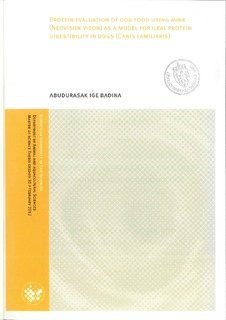| dc.description.abstract | Dog owners pay lot of attention on providing proper nutrition to their dog that will support longevity and good health. Great effort is therefore made by feed producers concerning information about nutritional quality of dog food ingredients and at to what extent they cover the nutritional requirement of dogs at different life stages. Protein and amino acid content and utilization is of great importance in the evaluation of pet food ingredients. A key factor in protein utilization is digestibility. In dogs digestion and absorption in the small intestine will be the main site for evaluating digestibility since 90 % of digestion take place in this part of the digestive tract. Ileal digestibility values will therefore be more correct than apparent total tract digestibility values that are influenced by degradation of protein in the colon. Degraded and metabolized protein from fermentation processes in the colon is not absorbed and utilized as amino acids in the small intestine. Microbial degradation produces volatile N compounds that will not be accounted for and therefore total tract digestibility values will overestimate protein digestibility. Ileal protein digestibility values require use of ileal cannulated dogs, which is an invasive method with ethical considerations. A non-invasive alternative to obtain ileal digestibility values would be to apply the mink (Neovison vison), a well established model animal in protein digestibility studies. Mink have been proposed to have a similar total tract digestive capacity as ileal digestion in the dog because of its much simpler digestive tract without caecum, rapid passage rate and low microbial activity in colon. The main objective of experimental part of this thesis was therefore to report a study comparing apparent total tract, colon and ileal digestibility of protein in dog with total tract digestibility in mink using three different protein sources applied in extruded dog food. Lamb meal, poultry meal and fishmeal was applied as main protein sources because of the expected gap in protein digestibility, lowest for lamb meal, intermediate for poultry meal and highest for fish meal. The results showed that overall apparent total tract values were significantly higher than values obtained from colon, ileum or as apparent total tract in mink. Values for apparent total tract, colon, ileum, and total tract in mink were 83.5, 78.5, 74.4 and 77.8%, respectively. Mink digestibility values were significantly different from ileal values but not from colon values. As expected the digestibility was generally lowest for the lamb meal food, intermediate for the poultry meal and highest for fish meal. The difference between total tract digestibility values and ileal values in the dog increased with decreasing digestibility. For the fish meal food the difference was 6.9 % while corresponding for the poultry meal and lamb meal food was 9.0 % and 11.4 %, respectively. This demonstrates the effect of fermentation and more important, that apparent total tract values overestimate poor digestible protein sources more than highly digestible. Even though mink digestibility values were higher than ileal values in the dog, they were generally closer to ileal values than apparent total tract values for the dog, and they appeared to be closer to ileal values with lower digestibility. Mink digestibility values were similar to values from colon, thus indicating that mink total tract digestibility can be ranked between apparent total tract and ileal in the dog. All methods were highly positively correlated showing coefficients from 0.857 to 0.959 (P<0.001).
Based on this result one can conclude that mink digestibility values for crude protein are lower than total tract and higher ileal values in dogs, but generally closer to ileal values when protein digestibility is poor. This observation strongly indicates that mink protein digestibility is an appropriate model for assessment of ileal protein digestibility in the dog. Overall the study confirms that protein digestibility values in mink are positively correlated to those obtained in total tract, ileum and colon in the dog. To achieve more precise information on mink digestibility as a model in the area amino acid digestibility values should be compared with ileal values in dogs. | no_NO |
